
Beech Bark Disease (Neonectria ditissima)
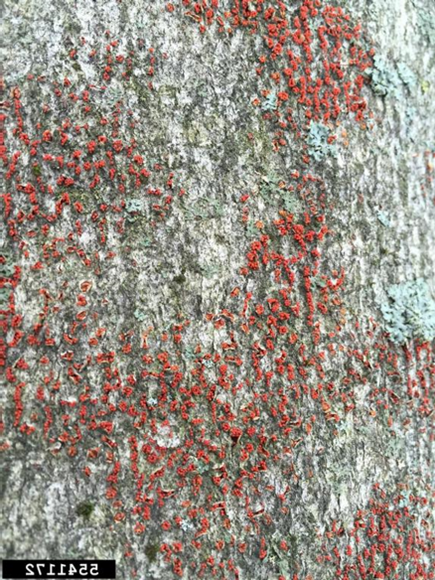
Beech bark disease (BBD) is the result of a complex interaction among three non-native species, including one insect and two pathogens, that affects American beech trees. The insect is a small scale insect whose feeding causes damage to the bark and vascular tissues of the beech tree. The pathogens are fungi that use the wounds created by the insect to gain entry to the beech tree. Once infected by Neonectria, beech trees weaken and develop cankers. Cankers spread over time, leading to branch and crown dieback and eventually tree mortality.
Biology
The insect: Beech scales are tiny (0.5 to 1.0 mm), yellow, soft-bodies insects that feed on beech trees. The have one generation per year and are parthenogenic, meaning reproduction is asexual and all progeny are female. Pale yellow eggs are laid on tree bark in mid summer and hatch between late summer and early winter. The immature scales, called crawlers, have functional antennae and legs and move around to find a suitable location on a host tree. Once a location is found, the crawler inserts its straw-like mouthpart through the bark and begins to suck sap from the tree. When feeding begins, the crawler molts into the second stage. Second-stage crawlers lose their legs and begin secreting a white, woolly protective wax covering. Beech scales overwinter as second-stage crawlers and molt into adults the following spring. As adults, they remain stationary and cover their bodies with their wax secretions.
The fungus: Trees that are infested by beech scale are stressed and have many wounds that make suitable entry points for the Neonectria fungi. Existing colonies of Neonectria produce fruiting bodies called perithecia, which are filled with sacs of spores. Perithecia are tiny bright red spheres that appear in clusters on bark. Spores in the perithecia are the sexual stage of the fungi and are released in the fall to be carried by the wind. These fungi can also form spores through an asexual process which produces white or pink cushions of spores on the bark before the perithecia appear. The asexual spores are found mid summer through fall and are also wind dispersed. When the fungus encounters a suitable host, it enters through the wounds created by feeding beech scale and quickly spreads beneath the bark, killing the tissue along its way.
Where it’s from
The beech bark disease complex is native to Europe. It was originally detected in Nova Scotia in the late 1800s and was likely brought over on imported ornamental beech trees.
How it spreads
Beech scale are mobile as early-stage crawlers, the only life stage with legs. When crawlers hatch, they may move to another area of the same tree or be blown to a nearby tree by the wind. Others may be carried greater distances by birds or other wildlife. The appearance of new infestations near campgrounds and recreational areas suggests that humans play a role in the long distance spread of beech scale, likely being transported on infested firewood.
Neonectria spreads much slower than beech scale. Existing infections produce spores which are carried by the wind and deposited on nearby trees. Forests can be infested with beech scale for several years before the fungi arrive.
Where it’s found
Beech bark disease entered the U.S. through Maine and has been spreading through the east since the early 1900’s.
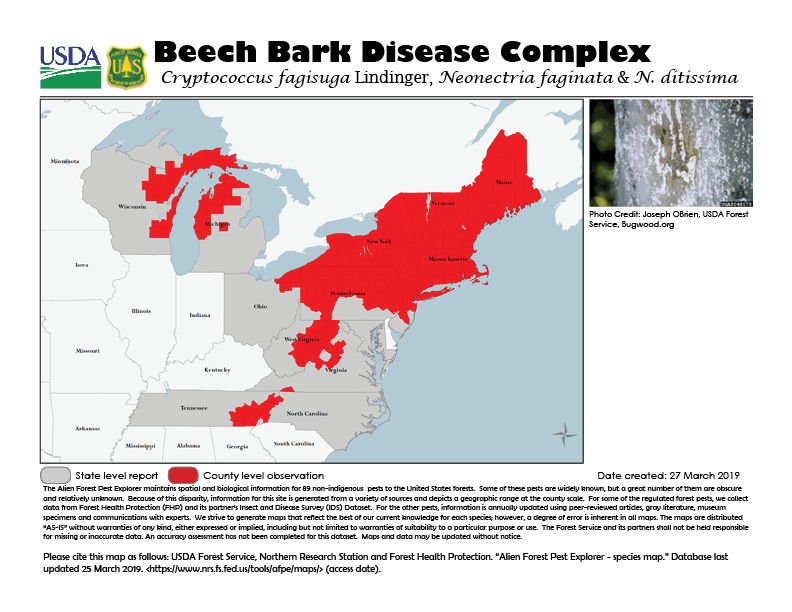
What’s being done
The USDA Forest Service has collaborated with many state agencies and universities to conduct research on beech bark disease. Their research efforts have shown that by controlling the beech scale insect, American beech trees are significantly less likely to succumb to BBD. Some beech trees have a natural resistance to the beech scale insect and researching this resistance is an important goal. Much research is aimed at discovering the best breeding practices and ensuring long-term survival of resistant trees. The goal is to eventually produce many resistant trees with the intention of replanting beech forests.
There are currently no quarantine regulations on beech scale, however they are yet another small, cryptic insect that may remain present on recently harvested beech trees. Firewood should never be moved out of an infested area as it may contain hidden pests.
Images of Beech Bark Disease and damage
Early/young infestations:
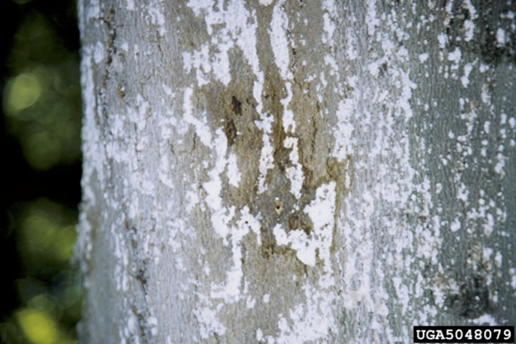
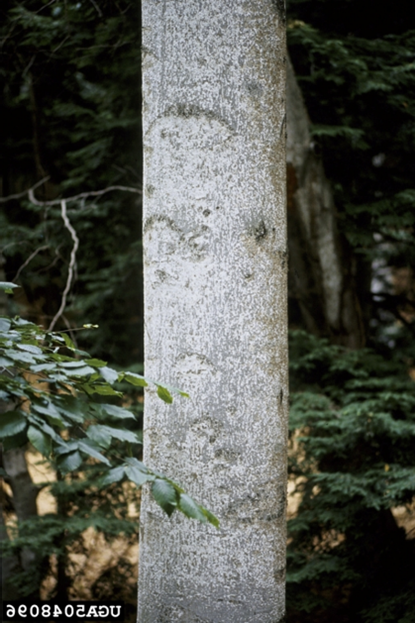
Older infestations or pests:
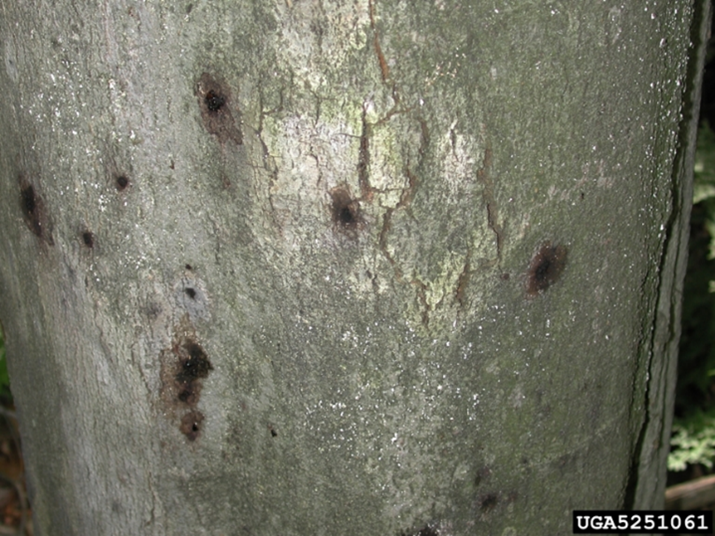
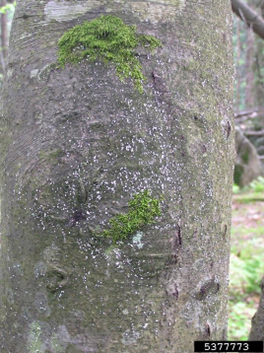
Images of infested trees
Early damage:
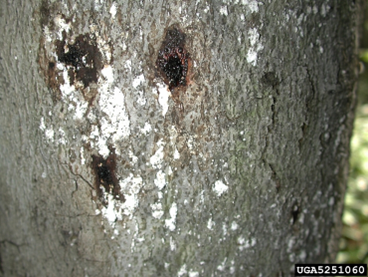
Later damage:
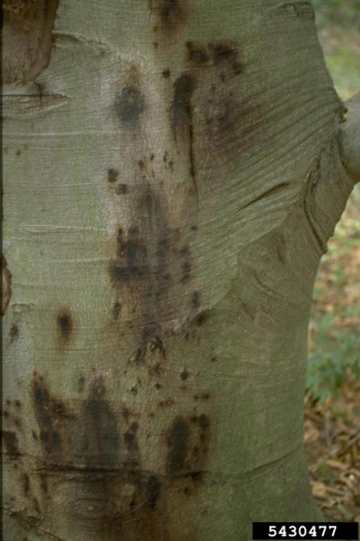
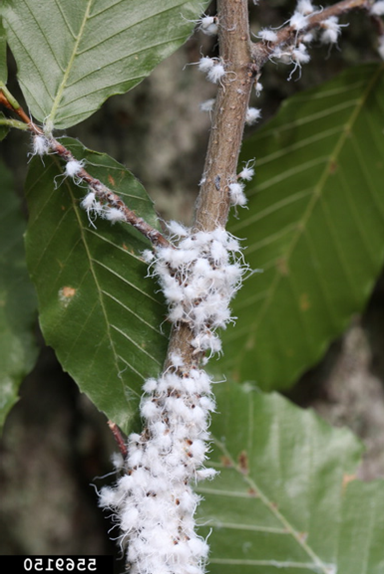
Look alikes:
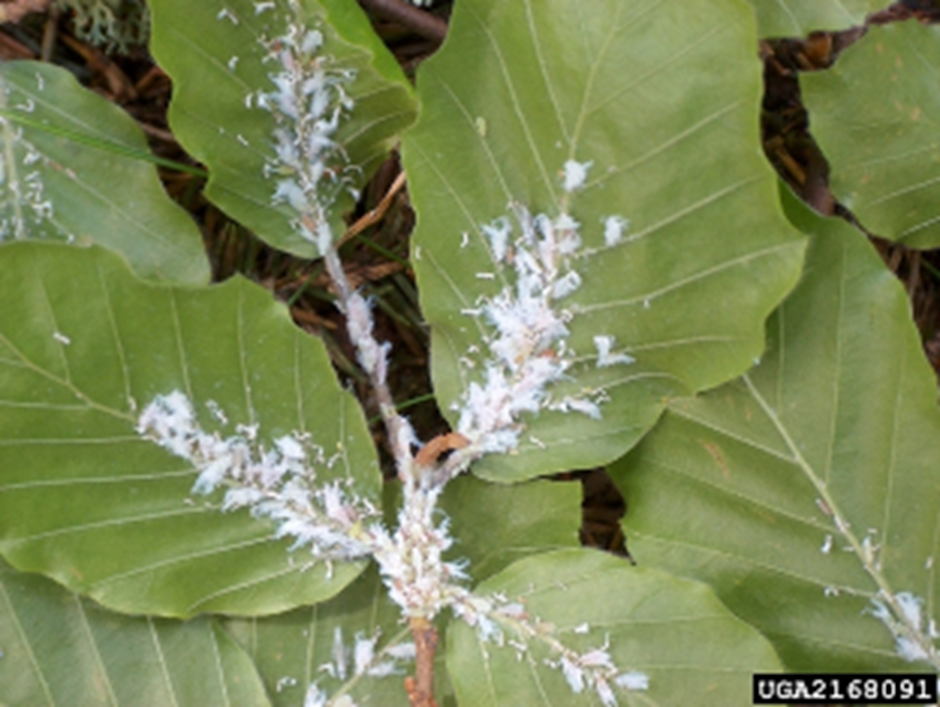
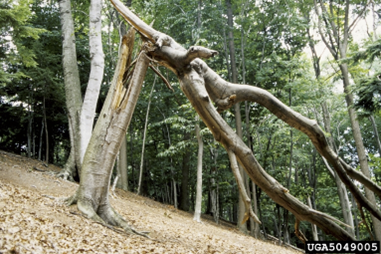
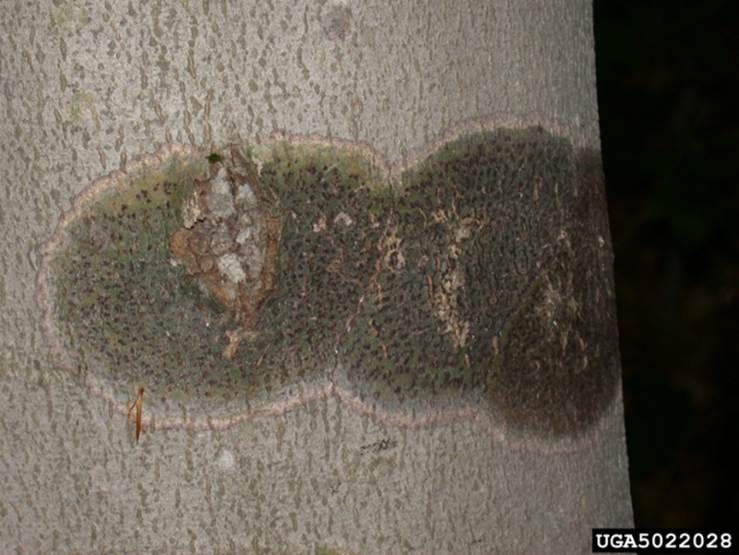
What can be done?
Management options for:
Homeowners –
Homeowners with large beech trees on their property should monitor them for patches of dead bark caused by BBD, which makes the trees vulnerable to breakage. If trees have dead tissues, they become hazardous to people and property and should be removed. If beech trees are not yet infected or are newly infested by the beech scale insect then some control options are available if protection is desired. Controlling the beech scale insect will substantially reduce the risk of infection by the fungus. Insect control on small trees can be obtained through physically scrubbing or spraying the beech scale off the tree with water, but for larger trees the beech scale in the upper canopy may be unreachable. Horticultural oils can be sprayed directly on the scale insect to suffocate them but should only be applied when trees are dormant. Other registered insecticides may also be used for insect control. If protection is desired by homeowners, it should be noted that it needs to be maintained long-term, as the beech scale insect will continually attack the trees. Homeowners should also monitor their beech trees for potential resistance. If residing in a BBD infested area, watch for resistant beech trees and report them as they can be used to breed more resistant trees. Lastly, individuals should never move firewood, of beech or any other tree species, outside an infected area.
Municipalities –
When patches of dead bark appear on large beech trees infected with BBD they become structurally weak and prone to breakage. These trees can be hazardous to people and property in campgrounds or other recreational and should be removed. If high-value or ornamental trees are not yet affected, they can be protected through controlling the scale insect.
It should be noted that if protection is desired, it needs to be maintained long-term, as the beech scale insect will continually attack the trees. Control can be done manually through scrubbing or spraying the insects off the tree with water, however, scales in the upper canopy are difficult to remove manually. Horticultural oils can be applied to kill the insect, but should only be applied when trees are dormant. Some registered insecticides can also be used to control beech scale.
There are no practical large-scale control options for forest stands other than salvaging dead or declining trees. In forests, managers should look for beech trees that exhibit resistance to beech scale as they can be used to breed more resistant trees that can be replanted in the forests. Other silvicultural practices can be used to minimize damages and encourage the regeneration of other tree species.
Regulatory information
There are currently no state or federal regulations in place to prevent the spread of BBD. Regulations that restrict the movement of firewood, however, include the wood from beech trees as firewood should never be move outside of an infested area.
Who to contact
-
Maine —
- Department of Agriculture, Conservation and Forestry
- Insect and disease reporting website
- Email: foresthealth@maine.gov
- Phone: (207) 287-2431
- University of Maine Cooperative Extension
- Phone: 207.832.0343 or 1.800.244.2104
- Email: extension@maine.edu
- Department of Agriculture, Conservation and Forestry
-
New Hampshire —
- Division of Forests and Land – Invasive Pest or Disease Reporting Form
- Phone: (603) 271-2214
-
University of New Hampshire Cooperative Extension —
- Phone: (603) 862-1520
-
Vermont —
- Department of Forests, Parks and Recreation
- Phone: 802-505-8259
- Email: Savannah.Ferreira@vermont.gov
- University of Vermont Extension
- Ginger Nickerson
- Phone: (802) 476-2003
- Email: ginger.nickerson@uvm.edu
- Ginger Nickerson
- Department of Forests, Parks and Recreation
-
Massachusetts —
- University of Massachusetts Amherst
- Phone: (413) 545-4800
- Email: ag@cns.umass.edu
- Department of Conservation and Recreation
- Phone: (617) 626-1250
- Email: mass.parks@mass.gov
- University of Massachusetts Amherst
-
Connecticut —
- Department of Forestry
- Phone: 860-424-3630
- Email: deep.forestry@ct.gov
- Department of Forestry
-
Rhode Island —
- Department of Environmental Management - Division of Forest Environment
- TeeJay Boudreau - Deputy Chief
- Phone: (401) 222-2445
- Invasive Species Sighting Report Form
- TeeJay Boudreau - Deputy Chief
- Department of Environmental Management - Division of Forest Environment
-
New Jersey —
- Department of Agriculture - Division of Plant Industry
- Joseph Zoltowski – Director
- Phone: 609-406-6939
- Email: joseph.zoltowski@ag.nj.gov
- Joseph Zoltowski – Director
- Department of Agriculture - Division of Plant Industry
-
New York —
- Department of Environmental Conservation - Division of Lands and Forests
- Phone: 518-402-9425
- Email: landsforests@dec.ny.gov
- Cornell Cooperative Extension
- David Gray Cox
- Phone: 518-234-4303 (x119)
- Email: dgc23@cornell.edu
- David Gray Cox
- Department of Environmental Conservation - Division of Lands and Forests
-
Pennsylvania —
- Department of Conservation and Natural Resources - Bureau of Forestry’s Division of Forest Health
- Phone: 717-783-2066
- Email: PaForester@pa.gov
- PennState Extension
- Phone: 1-877-345-0691
- Department of Conservation and Natural Resources - Bureau of Forestry’s Division of Forest Health
-
Maryland —
- University of Maryland - Department of Entomology
- Phone: 301 405-3911
- Email: http://entomology.umd.edu/
- Maryland Department of Agriculture - Forest Pest Management
- Craig Kuhn - Program Manager
- Phone: (410) 841-5870
- Email: craig.kuhn@maryland.gov
- Craig Kuhn - Program Manager
- University of Maryland - Department of Entomology
-
Virginia —
- Virginia Department of Forestry - Forest Management and Health
- Virginia Cooperative Extension - Woodland Management
- Jennifer Gagnon
- Email: jgagnon@vt.edu
- Jennifer Gagnon
-
West Virginia —
- West Virginia University Extension
- Dave McGill - Extension Specialist – Forest Resources
- Phone: 304-293-5930
- Email: DMcGill@wvu.edu
- Dave McGill - Extension Specialist – Forest Resources
- West Virginia Division of Forestry
- Phone: (304) 558-2788
- West Virginia University Extension
-
North Carolina —
- North Carolina Forest Service
- Phone: (919) 857-4801
- North Carolina State University Extension
- Kelly Oten - Extension Specialist, Forest Health
- Phone: (919) 515-5573
- Email: klfelder@ncsu.edu
- Kelly Oten - Extension Specialist, Forest Health
- North Carolina Forest Service
-
Tennessee —
- Department of Agriculture - Protect Tennessee Forests Program
- Phone: (615) 837-5520
- Email: Protect.TNForests@tn.gov
- University of Tennessee Extension – Forestry
- Dr. David Mercker - Extension Specialist
- Phone: 731-425-4703
- Email: dcmercker@utk.edu
- Dr. David Mercker - Extension Specialist
- Department of Agriculture - Protect Tennessee Forests Program
-
Ohio —
- Ohio Department of Natural Resources
- Tom Macy - Forest Health Program Administrator
- Phone: 614-265-6705
- Email: Thomas.macy@dnr.ohio.gov
- Tom Macy - Forest Health Program Administrator
- Ohio Department of Natural Resources
-
Michigan —
- Department of Natural Resources - Forest Health Division
- Phone: 517-284-5895
- Email: DNR-FRD-Forest-Health@michigan.gov
- Midwest Invasive Species Information Network Reporting webpage
- Michigan State University Extension
- Julie Crick - Extension Educator
- Phone: 989-275-7179Email: crickjul@msu.edu
- Department of Natural Resources - Forest Health Division
-
Wisconsin —
- Wisconsin Department of Natural Resources
- Andrea Diss-Torrance – Invasive forest insects program coordinator
- Phone: (608) 516-2223
- Email: Andrea.DissTorrance@wisconsin.gov
- Kyoto Scanlon – Forest Pathologist
- Phone: (608) 235-7532
- Email: Kyoko.Scanlon@wisconsin.gov
- Andrea Diss-Torrance – Invasive forest insects program coordinator
- University of Wisconsin-Madison Division of ExtensionAnne Pearce - Wisconsin First Detector Network Coordinator Phone: 608-262-9570 Email: WIFDNcoordinator@gmail.com
- Wisconsin Department of Natural Resources
-
USDA Forest Service —
- Jennifer Koch - Northern Research Station Research Biologist
- Phone: 740-368-0188
- Email: jennifer.koch@usda.gov
- Jennifer Koch - Northern Research Station Research Biologist